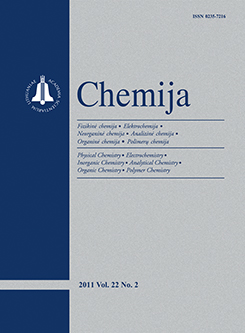Chemija / Chemistry
WHAT?
 ISSN 0235-7216 ISSN 2424-4538 (online) |
2011 m. Nr. 4 Antiplasmodial in vitro activity of chysanthemoylsubstituted
quinones: roles of single-electron reduction potential and glutathione reductase inhibition
Although quinones have been a subject of great interest as possible antimalarial agents, their mechanisms of action against the malaria parasite Plasmodium falciparum are vaguely understood. Flavoenzyme electrontransferase-catalyzed single-electron reduction with the subsequent redox cycling and oxidative stress that accelerates with an increasing the the quinone / semiquinone redox couple (single-electron reduction potential, E17), and the inhibition of the antioxidant flavoenzyme glutathione reductase (GR, EC 1.8.1.7) have been proposed, among several possible mechanisms. Here, we examined the in vitro activity against the P. falciparum strain FcB1 and the inhibition activity of P. falciparum GR several previously uninvestigated hydroxynaphtho- and hydroxyanthraquinones and their esters of chrysanthemic acid. Taken together with our previous results, the obtained data point to a less pronounced role of E17 in the antiplasmodial activity of quinones as compared with their mammalian cell cytotoxicity, and to a modest role of GR inhibition underlying the other dominant mechanisms of quinone action. However, it also implies that quinones with a low reduction potential may be used as relatively efficient antiplasmodial agents with a low mammalian cell cytotoxicity.
Keywords: Plasmodium falciparum, quinones, glutathione reductase |
Issues:
2017 - Vol.28 No. 1, No. 2, No. 3, No. 4 2016 - Vol.27 No. 1, No. 2, No. 3, No. 4 2015 - Vol.26 No. 1, No. 2, No. 3, No. 4 2014 - Vol.25 No. 1, No. 2, No. 3, No. 4 2013 - Vol.24 No. 1, No. 2, No. 3, No. 4 2012 - Vol.23 No. 1, No. 2, No. 3, No. 4 2011 - Vol.22 No. 1, No. 2, No. 3, No. 4 2010 - Vol.21 No. 1, No. 2-4 2009 - Vol.20 No. 1, No. 2, No. 3, No. 4 2008 - Vol.19 No. 1, No. 2, No. 3-4 2007 - Vol.18 No. 1, No. 2, No. 3, No. 4 2006 - Vol.17 No. 1, No. 2-3, No. 4 2005 - Vol.16 No. 1, No. 2, No. 3-4 2004 - Vol.15 No. 1, No. 2, No. 3, No. 4 2003 - Vol.14 No. 1, No. 2, No. 3, No. 4 2002 - Vol.13 No. 1, No. 2, No. 3, No. 4 2001 - Vol.12 No. 1, No. 2, No. 3, No. 4 |